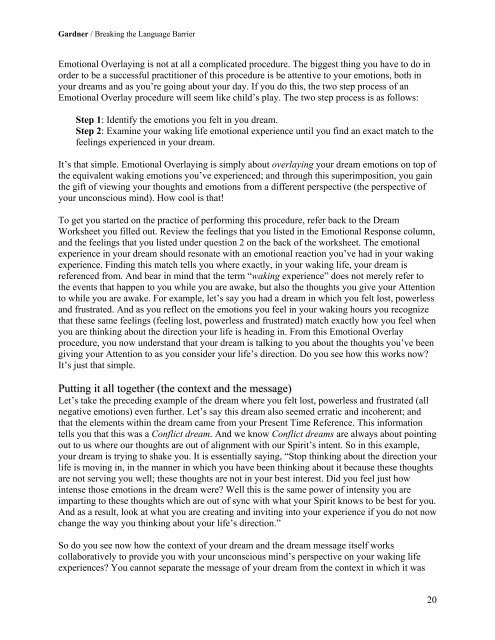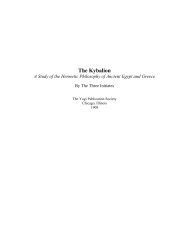Breaking the Language Barrier: Learning to Interpret Your Dreams
Breaking the Language Barrier: Learning to Interpret Your Dreams
Breaking the Language Barrier: Learning to Interpret Your Dreams
You also want an ePaper? Increase the reach of your titles
YUMPU automatically turns print PDFs into web optimized ePapers that Google loves.
Gardner / <strong>Breaking</strong> <strong>the</strong> <strong>Language</strong> <strong>Barrier</strong><br />
Emotional Overlaying is not at all a complicated procedure. The biggest thing you have <strong>to</strong> do in<br />
order <strong>to</strong> be a successful practitioner of this procedure is be attentive <strong>to</strong> your emotions, both in<br />
your dreams and as you’re going about your day. If you do this, <strong>the</strong> two step process of an<br />
Emotional Overlay procedure will seem like child’s play. The two step process is as follows:<br />
Step 1: Identify <strong>the</strong> emotions you felt in you dream.<br />
Step 2: Examine your waking life emotional experience until you find an exact match <strong>to</strong> <strong>the</strong><br />
feelings experienced in your dream.<br />
It’s that simple. Emotional Overlaying is simply about overlaying your dream emotions on <strong>to</strong>p of<br />
<strong>the</strong> equivalent waking emotions you’ve experienced; and through this superimposition, you gain<br />
<strong>the</strong> gift of viewing your thoughts and emotions from a different perspective (<strong>the</strong> perspective of<br />
your unconscious mind). How cool is that!<br />
To get you started on <strong>the</strong> practice of performing this procedure, refer back <strong>to</strong> <strong>the</strong> Dream<br />
Worksheet you filled out. Review <strong>the</strong> feelings that you listed in <strong>the</strong> Emotional Response column,<br />
and <strong>the</strong> feelings that you listed under question 2 on <strong>the</strong> back of <strong>the</strong> worksheet. The emotional<br />
experience in your dream should resonate with an emotional reaction you’ve had in your waking<br />
experience. Finding this match tells you where exactly, in your waking life, your dream is<br />
referenced from. And bear in mind that <strong>the</strong> term “waking experience” does not merely refer <strong>to</strong><br />
<strong>the</strong> events that happen <strong>to</strong> you while you are awake, but also <strong>the</strong> thoughts you give your Attention<br />
<strong>to</strong> while you are awake. For example, let’s say you had a dream in which you felt lost, powerless<br />
and frustrated. And as you reflect on <strong>the</strong> emotions you feel in your waking hours you recognize<br />
that <strong>the</strong>se same feelings (feeling lost, powerless and frustrated) match exactly how you feel when<br />
you are thinking about <strong>the</strong> direction your life is heading in. From this Emotional Overlay<br />
procedure, you now understand that your dream is talking <strong>to</strong> you about <strong>the</strong> thoughts you’ve been<br />
giving your Attention <strong>to</strong> as you consider your life’s direction. Do you see how this works now<br />
It’s just that simple.<br />
Putting it all <strong>to</strong>ge<strong>the</strong>r (<strong>the</strong> context and <strong>the</strong> message)<br />
Let’s take <strong>the</strong> preceding example of <strong>the</strong> dream where you felt lost, powerless and frustrated (all<br />
negative emotions) even fur<strong>the</strong>r. Let’s say this dream also seemed erratic and incoherent; and<br />
that <strong>the</strong> elements within <strong>the</strong> dream came from your Present Time Reference. This information<br />
tells you that this was a Conflict dream. And we know Conflict dreams are always about pointing<br />
out <strong>to</strong> us where our thoughts are out of alignment with our Spirit’s intent. So in this example,<br />
your dream is trying <strong>to</strong> shake you. It is essentially saying, “S<strong>to</strong>p thinking about <strong>the</strong> direction your<br />
life is moving in, in <strong>the</strong> manner in which you have been thinking about it because <strong>the</strong>se thoughts<br />
are not serving you well; <strong>the</strong>se thoughts are not in your best interest. Did you feel just how<br />
intense those emotions in <strong>the</strong> dream were Well this is <strong>the</strong> same power of intensity you are<br />
imparting <strong>to</strong> <strong>the</strong>se thoughts which are out of sync with what your Spirit knows <strong>to</strong> be best for you.<br />
And as a result, look at what you are creating and inviting in<strong>to</strong> your experience if you do not now<br />
change <strong>the</strong> way you thinking about your life’s direction.”<br />
So do you see now how <strong>the</strong> context of your dream and <strong>the</strong> dream message itself works<br />
collaboratively <strong>to</strong> provide you with your unconscious mind’s perspective on your waking life<br />
experiences You cannot separate <strong>the</strong> message of your dream from <strong>the</strong> context in which it was<br />
20






